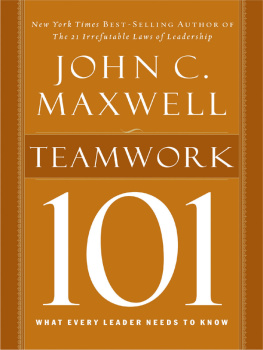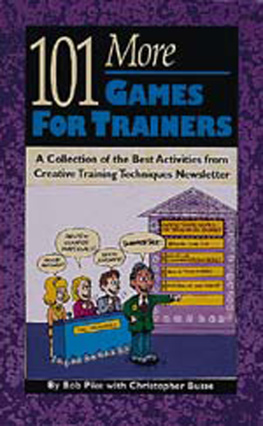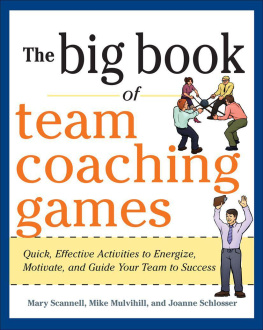365 LOW OR NO Cost Workplace Team Building Activities: Games and Exercises Designed to Build Trust and Encourage Teamwork Among Employees
Copyright 2017 Atlantic Publishing Group, Inc.
1405 SW 6th Avenue Ocala, Florida 34471 Phone 800-814-1132 Fax 352-622-1875
Website: www.atlantic-pub.com Email: sales@atlantic-pub.com
SAN Number: 268-1250
No part of this publication may be reproduced, stored in a retrieval system, or transmitted in any form or by any means, electronic, mechanical, photocopying, recording, scanning, or otherwise, except as permitted under Section 107 or 108 of the 1976 United States Copyright Act, without the prior written permission of the Publisher. Requests to the Publisher for permission should be sent to Atlantic Publishing Group, Inc., 1405 SW 6th Avenue, Ocala, Florida 34471.
Library of Congress Cataloging-in-Publication Data
Names: Peragine, John N., author. | Hudgins, Grace, author.
Title: 365 low or no cost workplace teambuilding activities : games and
exercises designed to build trust and encourage teamwork among employees /
by John Peragine ; revised by Grace Hudgins Other titles: Three hundred sixty five low or no cost workplace teambuilding
activities
Description: Revised 2nd edition. | Ocala, Florida : Atlantic Publishing
Group, Inc., [2016] | Includes bibliographical references and index.
Identifiers: LCCN 2015036709| ISBN 9781620230671 (alk. paper) | ISBN
1620230674 (alk. paper)
Subjects: LCSH: Teams in the workplace. | Interpersonal communication. |
Communication in organizations.
Classification: LCC HD66 .P427 2016 | DDC 658.4/022--dc23 LC record available at https://lccn.loc.gov/2015036709
LIMIT OF LIABILITY/DISCLAIMER OF WARRANTY: The publisher and the author make no representations or warranties with respect to the accuracy or completeness of the contents of this work and specifically disclaim all warranties, including without limitation warranties of fitness for a particular purpose. No warranty may be created or extended by sales or promotional materials. The advice and strategies contained herein may not be suitable for every situation. This work is sold with the understanding that the publisher is not engaged in rendering legal, accounting, or other professional services. If professional assistance is required, the services of a competent professional should be sought. Neither the publisher nor the author shall be liable for damages arising herefrom. The fact that an organization or Web site is referred to in this work as a citation and/or a potential source of further information does not mean that the author or the publisher endorses the information the organization or Web site may provide or recommendations it may make. Further, readers should be aware that Internet Web sites listed in this work may have changed or disappeared between when this work was written and when it is read.
TRADEMARK DISCLAIMER: All trademarks, trade names, or logos mentioned or used are the property of their respective owners and are used only to directly describe the products being provided. Every effort has been made to properly capitalize, punctuate, identify, and attribute trademarks and trade names to their respective owners, including the use of and wherever possible and practical. Atlantic Publishing Group, Inc. is not a partner, affiliate, or licensee with the holders of said trademarks.
Printed in the United States
PROJECT MANAGER AND EDITOR: Rebekah Sack rsack@atlantic-pub.com
INTERIOR LAYOUT AND JACKET DESIGN: Diana Russell dianarussell@diana-russell-design.com
COVER DESIGN: Jackie Miller millerjackiej@gmail.com
Foreword
T eam building demands patience, persistence, and continuous evolution. Games and exercises function to stress the importance of certain aspects of effective teams: trust, communication, and cultural awareness, just to name a few. Taking those lessons into daily work demands that leaders exemplify the qualities they seek to instill across the team.
My earliest lessons in team building and leadership began in the humblest of jobs as a teenager washing dishes in a locally-owned Italian restaurant and pizzeria in Upstate New York. The owner insisted that he would never give a task to an employee that he would not also do himself. By jumping into a dumpster with brushes, soap, and a hose; or diving into the huge pile of dishes during a Friday night rush; or tossing flattened dough high into the air, he lived his words. His philosophy and actions instilled respect for him from all the employees. When he asked a staff member for assistance in a task, we saw that he operated transparently and humbly. We always complied without complaint.
The drawback of that lesson is that its culture-bound and rooted in American independence with appeal to equality and accountability among team members. When my career path placed me managing a team of 16 employees across the world in Kenya, that down-to-earth style conflicted with strong hierarchical tendencies and respectful submission to authority. I recognized that my responsibility as a leader demanded that I change to lead that team, although I could not fully shift my basic philosophy. Over my first year with the Kenyan team, I learned which employees embraced more authority and decision making and those that functioned best with a direct, command-style approach.
A leader must recognize that each team is unique, and in our multi-cultural society, each team member will bring along cultural assumptions. Some of the exercises in this edition are designed to highlight those differences to aid teams in being more effective as they adjust to each other.
Remote teams pose specific challenges for leaders, and with pervasive technology that allows team members to work from wherever they are, leaders must foster trust. This is essential. But how? Be responsive, be accessible, be flexible, be inclusive particularly with communications and keep a good sense of humor. With a remote team spanning the U.S. from Seattle to Tampa, I erred multiple times presuming I understood a written comment or question when, in fact, the author had very different intentions. I found myself fuming, only to realize later that my interpretation veered wildly from the team members meaning. Now when that occurs, Ive learned to call or to speak via online face-to-face technology not respond in writing and seek clarification. This volume provides leaders informative and practical activities to help bring remote teams together in a virtual sense.
In using this book, take stock of which exercises are suitable for your team, their personalities, and the needs of your organization at the time you develop or adapt the activity. Understand that the game or exercise ignites the beginning of the change you seek and that your daily interactions with team members must also reinforce the quality or value behind the games purpose. Most of all, be open to truly hearing your teams responses and reactions in the debrief as you will glean valuable insights to propel you to be a better leader tomorrow than you are today.
Dr. Shawn J. Woodin













